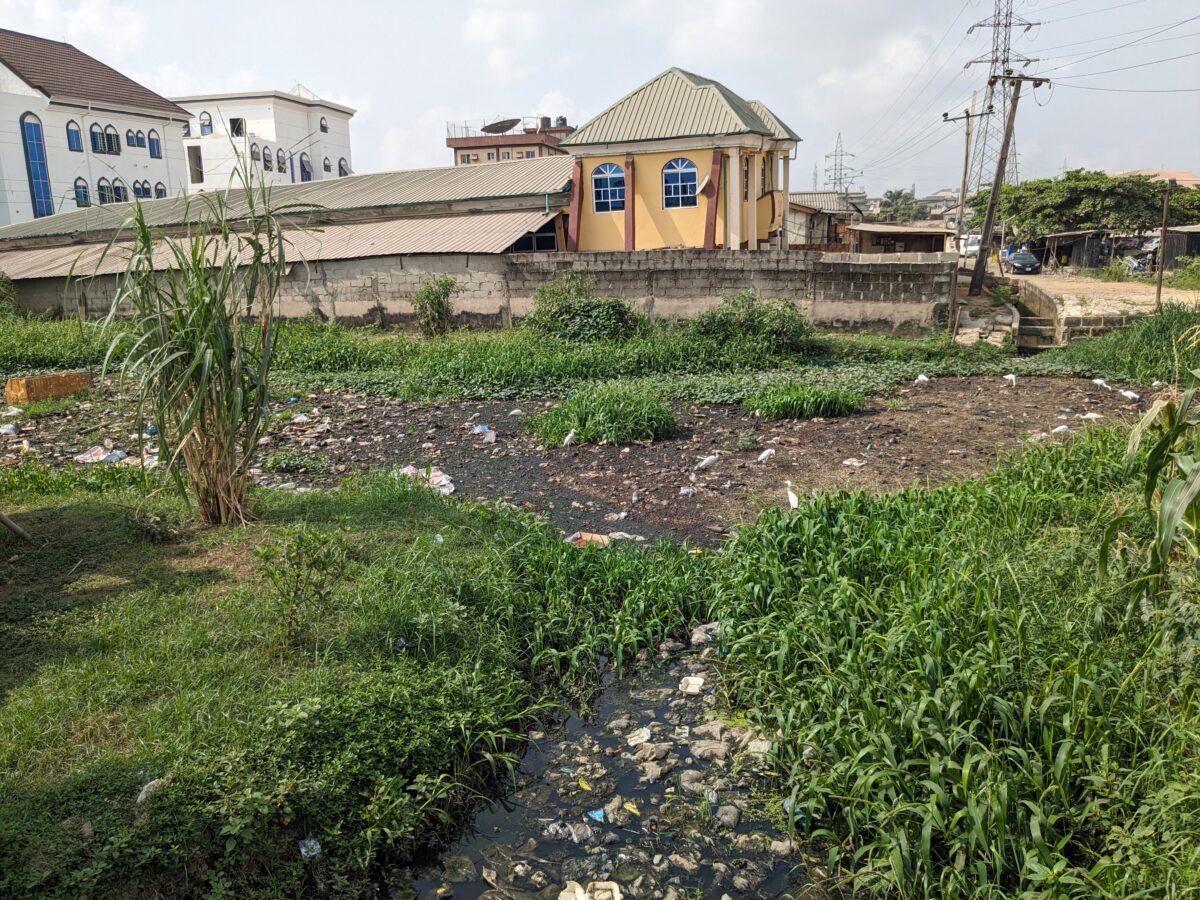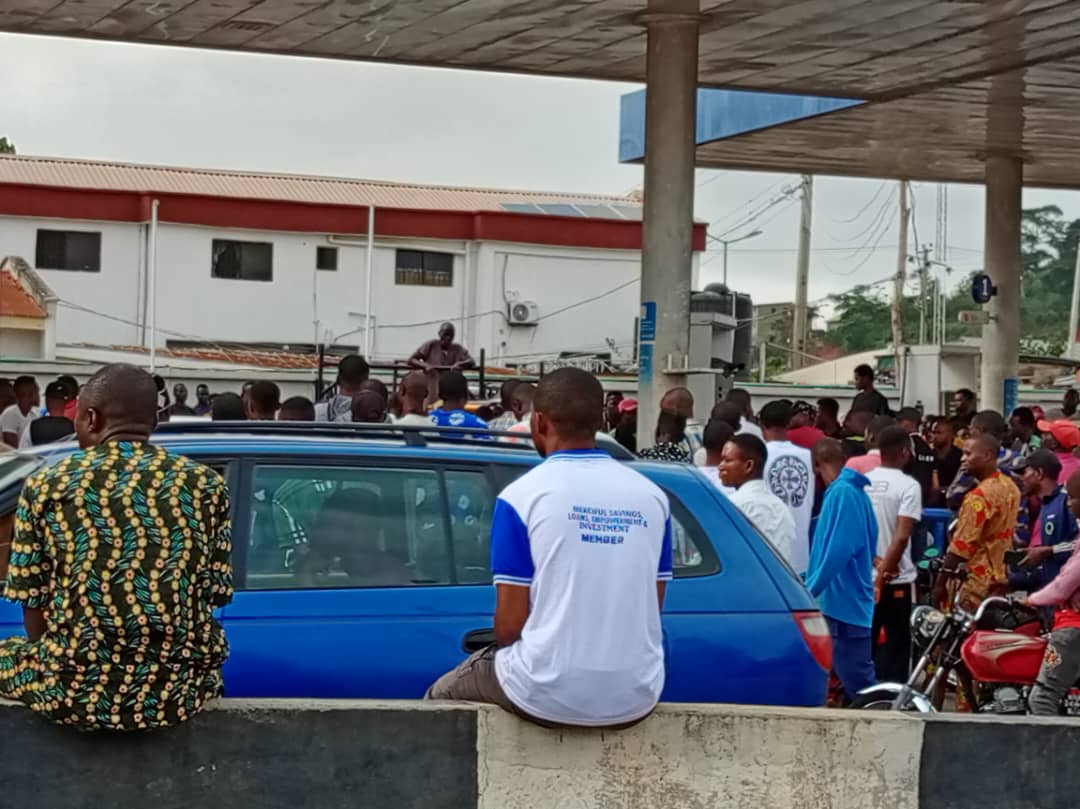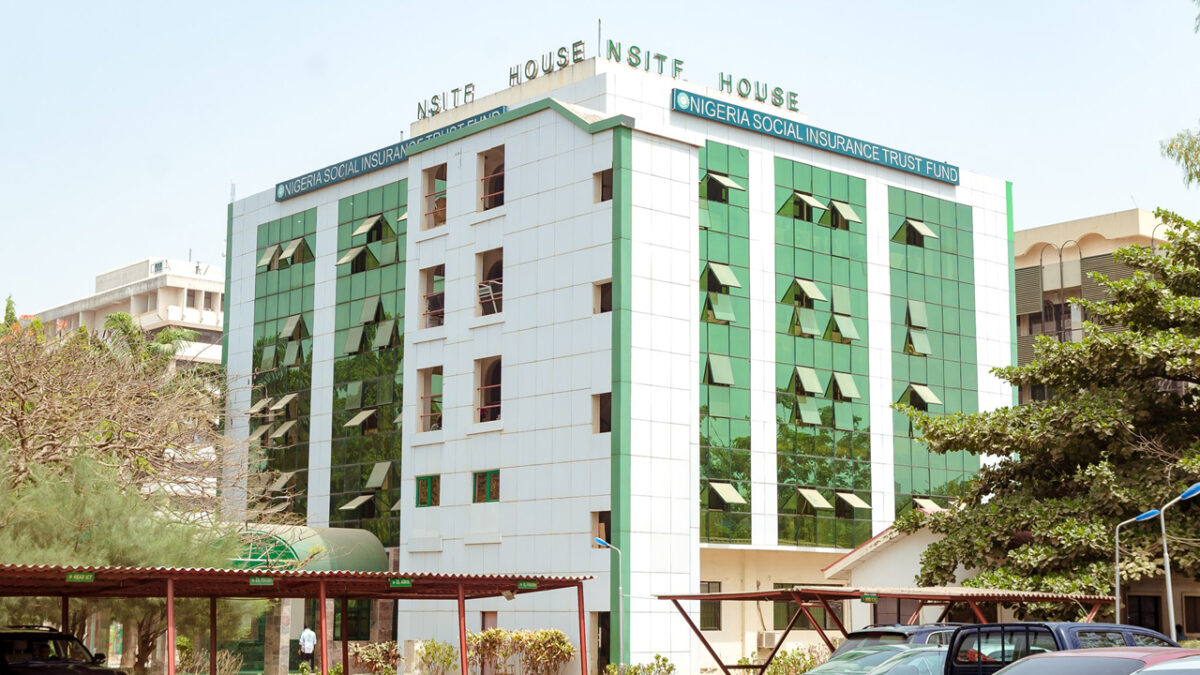In this place, residents of Lagos State bear the risk of ill health due to poorly treated wastewater dumped daily in the Odo Iya Alaro River. The residents, whose apartment buildings lie close and far away from the canal, are aware of the danger that they are being exposed to, and they will not give up until realistic measures are put in place to stop the practice.
It was early in the morning on February 15. Ezekiel Adeola* was preparing food for her family on Olatunji Street in the Ojota area of Lagos State. The fair-skinned woman was warmly receptive when this reporter approached her. She temporarily left the hearth where she was cooking to speak to me.
Adeola was interested in speaking to FIJ, and it did not take many prompts for her to speak her mind: “Yes, raw sewage collectors close to the bridge discharge wastewater into the water and it comes down here. Here, we have seen the good and the bad since we relocated to this place. Very early in the morning, when they are freshly emptying the wastewater into the river, a strong stench will mix with the air. Although this place doesn’t look nice, we have limited options.”
READ ALSO: Undercover as a Smuggler
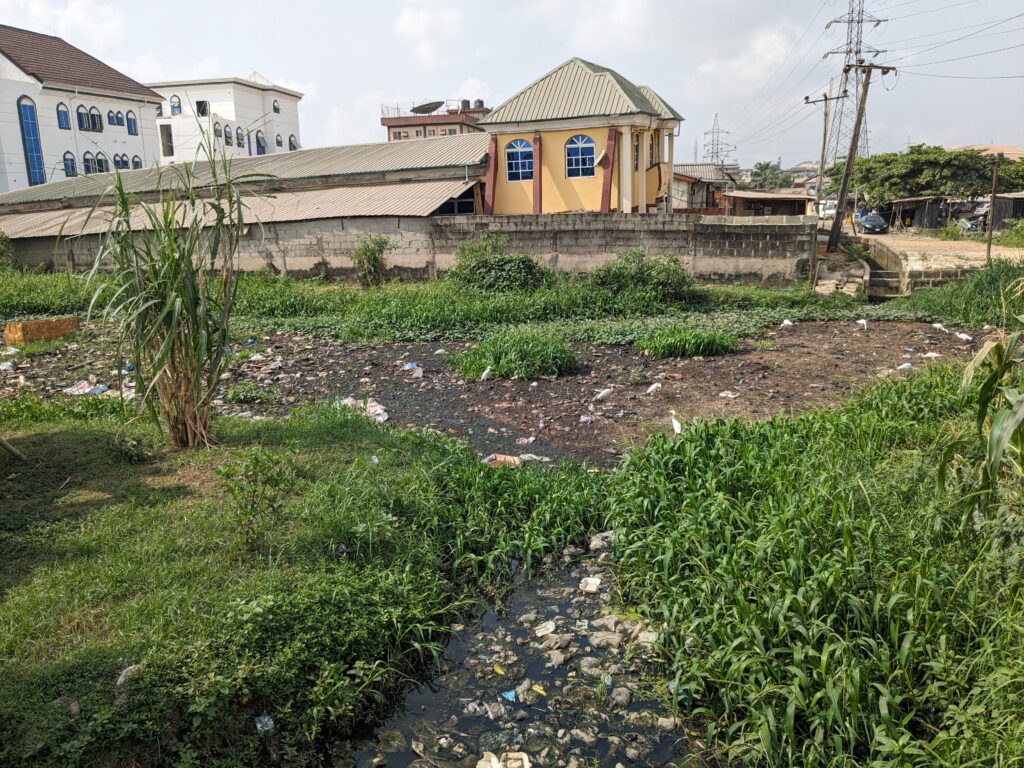
“We all talk about this problem,” Adeola said. “The community development association (CDA) sits down and deliberates about the canal regularly. It has not been easy for us because each rainy season brings fears to some of us, particularly those of us whose houses are a few perimeters away from the canal.”
Lateef Mutiu* remembered the canal was last dredged to a reasonable depth about a decade ago and that was the last time the community heaved a sigh of relief from flooding and terrible odours. Other residents who spoke with FIJ confirmed Mutiu’s statement.
In July 2019, the Lagos State government published a plan to dredge some river channels, including the Odo Iya Alaro River, in the state. But Mutiu and Adeola said the officials who did the clearing did a bad job, which informed their statement that the last proper dredging was done about 10 years ago.
“They did not just do a poor job; we were practically begging them to extend the work beyond that point. Our pleading was not meaningful until we contributed some money and gave it to them. Even now, you have come at a time when we are working on raising money to beg Julius Berger’s workers to come and dredge it for us,” Mutiu said, pointing at a floodplain beside a Cherubim and Seraphim Church parish.
“The depth they cleared was not deep. Now you can simply walk over the river to the Mende side. They only removed the weeds and other floating elements on the water; they did not go far. It doesn’t work that way. The government should realise that people are living around here and make sure that our lives are not endangered by the activities of the plant.”
A few times, some residents on Olatunji Street said Julius Berger, the contractor handling the building of a 3.89 km Ojota-Opebi-Ojota link bridge, had cleared a small portion of the river not far from the Iya Alaro bridge. This was clear from the appearance of the river from the bridge up to the point where the plant is located.
TREATMENT PLANT, FILTHY RIVER

Despite not maintaining the waterway regularly, business operations have never stopped at the treatment plant. The management of the plant had no responsibility for maintaining or putting it in good condition to prevent an epidemic from breaking out, this newspaper found.
Raw wastewater collected from homes, industries and hospitals in different parts of the state by waste tankers lands in the river. Before landing in the river, it undergoes the most basic treatment process. The sight of these brown-and-yellow-painted vehicles by the bridge was almost irresistible. Under the bridge were different types of business people, including crafters and weavers of solid wood furniture, food vendors, retailers and construction workers. Added to this were smokers, said to be cultists, who visibly polluted the air with smoke.
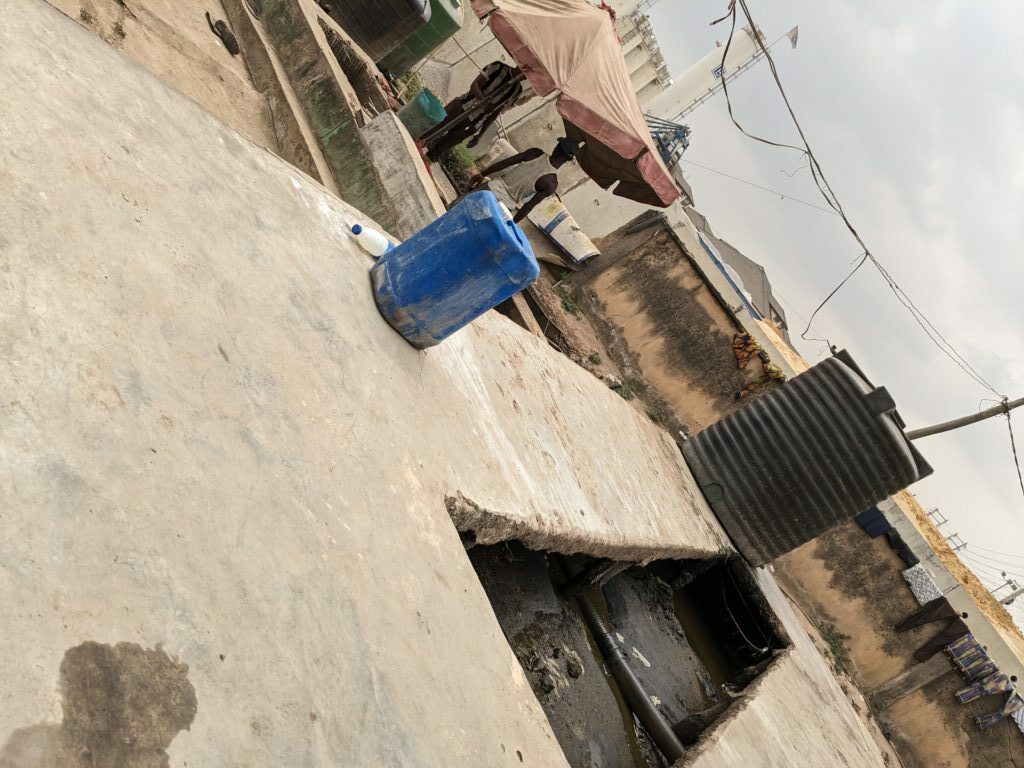
The river water flows from places like Agege, Ogba and Ogudu, and passes through Odo Iya Alaro and then into the lagoon. At the sewage plant, the only evidence of treatment was a rectangular concrete chamber with an open side in the middle that provides a broader view into its inner side and a black water tank. Other than these, there was no sight of any treatment machine or mechanical engine meant to filter and process waste into something harmless. The river acts as a boundary marker between Ojota and Mende, both within the administrative jurisdiction of Kosofe Local Government Area.
For the part of the river that could be tracked, FIJ found that immediately after the plant, the river had become narrow and stagnant. After Olatunji Street are Kujore, Victoria and Cele Emmanuel streets, all low-income and average-income residential neighbourhoods, where lives are at risk of disease outbreaks owing to the poor management of the Odo Iya Alaro. While there is no question about the plant’s legal existence or official approval, there is, indeed, a question about its social and environmental obligations to keep these human settlements safe.
Some delicately built houses were gradually succumbing to the existential threat posed by frequent floods in the highly urbanised neighbourhoods. Evidence of this was not difficult to see on Kujore Street, the same street where the government-approved Odo Iya Alaro Shrine is located.
At Cele Emmanuel, a very long apartment bungalow that poked its nose into the river has been deserted by its occupants and appears to have long been forgotten by its owner. The building was practically erected on the river path. From Olatunji Street down to this place tracked between February 15 and 21 by FIJ, silt from the treatment plant stood stagnantly on floodplains and was driven into the streets during a rainfall.
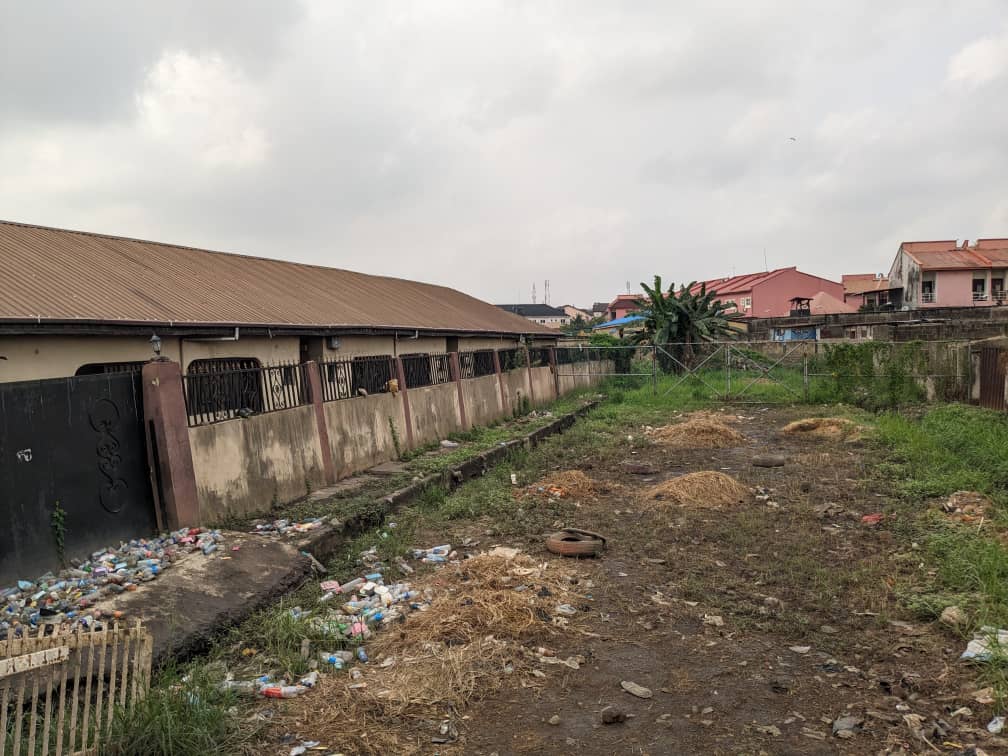
On this reporter’s return to the area on February 20, after an early morning rainfall, very dark pools of flood ravaged some lengths of the four streets, staying stagnant at the gates and doorsteps of about 10 houses on each street. The water dried up the following day but left behind observable traces on the ground and in the atmosphere. There was a foul smell of the silt and filth. The end result could be diseases.
The wastewater plant, known as Odo Iya Alaro Wastewater Treatment Plant, is situated by the riverside. Created by the government of Raji Fashola in 2014, Lekan Shodeinde, then coordinator of the Lagos State Wastewater Management Agency, was quoted as saying that the plant, with a capacity to treat 25 million litres of wastewater daily, cost the government N5.2 billion.
“At least we have 20 million people living in Lagos State, and each uses 100 litres of water daily. This accounts for two billion litres; out of this, 80 percent (1.6 billion litres) becomes waste water,” Shodeinde said in a report. “Aside from these new plants, the state government recently embarked on the construction of the Odo Iya Alaro wastewater treatment plant. This plant has the capacity to treat 25 million litres of wastewater daily. And it cost the state government N5.2 billion.”
At least 20 sewage tankers operated at the plant, per a count this reporter did while at the plant on one occasion, some of which frequently went out to collect wastewater and return to the plant to discharge its content by paying over N5,000 to the management. Once they returned, plant workers, who were mostly young people, stood up to empty the tank into the septic chamber barely without any safety gear.
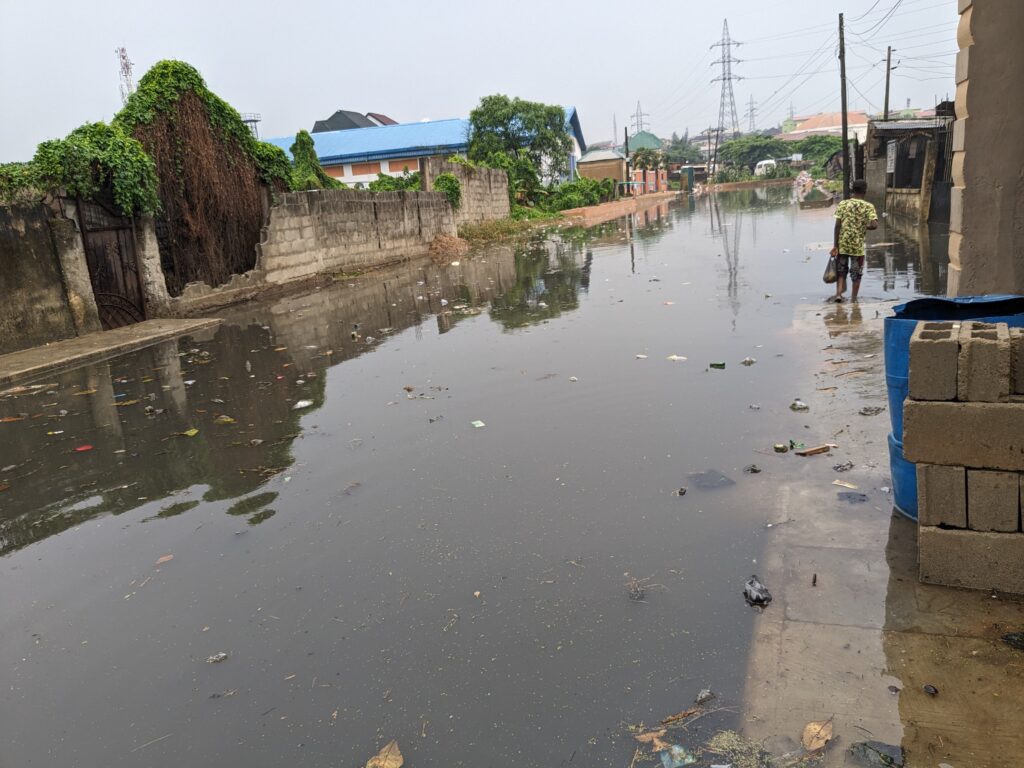
Statewide, about 15,000 metric tonnes of waste are generated per day. How much wastewater the treatment facility receives daily could not be confirmed, as the facility management failed to comment on it. But Shodeinde’s 10-year-old statement that it could treat 25 million litres of wastewater daily provides an idea of how much waste the plant actively releases into the river body. These wastes go into the river through a soil-cover pipe. At the end of the covered pipe, a thick body of sediment was noticeable inside the canal.
RELOCATION OR PROPER MANAGEMENT
Some residents and their children fell sick regularly and patronised medicine shops or medicine hawkers on the street. But they did not know the causes of their regular illnesses. In a densely populated area, the residents rely on underground wells and boreholes. While some households drink water collected from their own water sources, others cannot. They, however, still use the water for chores. Close to the canal were irregular slum houses ridden with mud and grass, where society’s have-nots were inevitably sheltered.
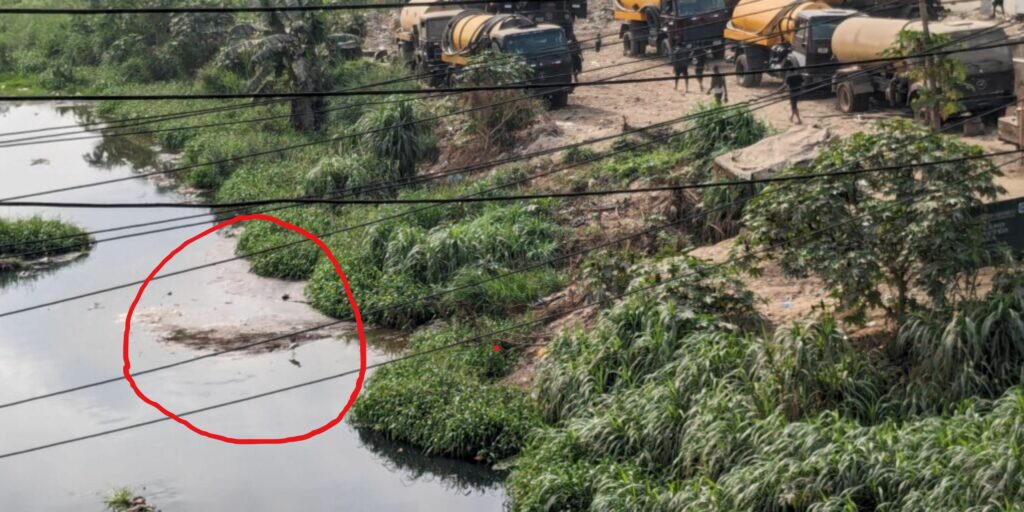
For their own safety and public concerns, they reached a consensus about what they wanted the authorities to do. Michael Owolabi, the CDA chairman, explained that the community had written numerous letters and physically engaged with government representatives at Alausa, where they expressed their challenges.
“We have been living in fear for many years. Our immediate solution is for the government to relocate the treatment plant. Many times we go to bed perceiving a strong stench from the river. When we wake up, the atmosphere is still the same,” Owolabi said. “It’s like a double jeopardy; we get to battle with flooding, which prevents some of us from sleeping in our houses when it happens, and the fear of disease outbreak due to dangerous discharge from the sewage plant.”
Owolabi has been involved in numerous engagements to call the authorities’ attention to their plights. At the time the government established the plant, he said, the area was relatively small in population, unlike today, when the population has grown.
“At the time they created it, this area was relatively small compared to what we have now. The way they release waste into the water exposes us to dangers,” Owolabi said further.
“Many people, including children, frequently fall sick here. But their parents could not take them for a proper diagnosis because of a lack of money. They would simply take self-prescribed drugs or consult a quack chemist – their only cheap option. I am sure if we carry out thorough health checks here, many people will test positive for different diseases as a result of this bad sewage management.
“If they cannot take it elsewhere, they should prioritise adequate management, and the government should put them on their toes. Their current operational practice does not allow the sewage dumped inside the river to flow away. It is impacting us badly.”
STANDARD TREATMENT PROCESS VS WHAT THE PLANT DOES
Wastewater treatment involves a long detoxification procedure. From preliminary, primary and secondary treatments, the aim is to completely render the wastewater free of danger to human health as well as minimise the risk to the natural environment.
Preliminary treatment involves the removal of coarse solids and other large materials usually found in raw wastewater. The second stage, primary treatment, is the process of removing settleable organic and inorganic solids by sedimentation and floatable materials (scum) by skimming. Thirdly, secondary treatment helps to further treat the effluent from primary treatment to separate the residual organics and suspended solids, while tertiary treatment is targeted at removing specific wastewater constituents that cannot be removed by secondary treatment.
The above processes, outlined in an article published by the Food and Agriculture Organisation (FAO) and also basically highlighted here, stated that each of the individual treatment processes is necessary to remove nitrogen, phosphorus, additional suspended solids, refractory organics, heavy metals and dissolved solids.
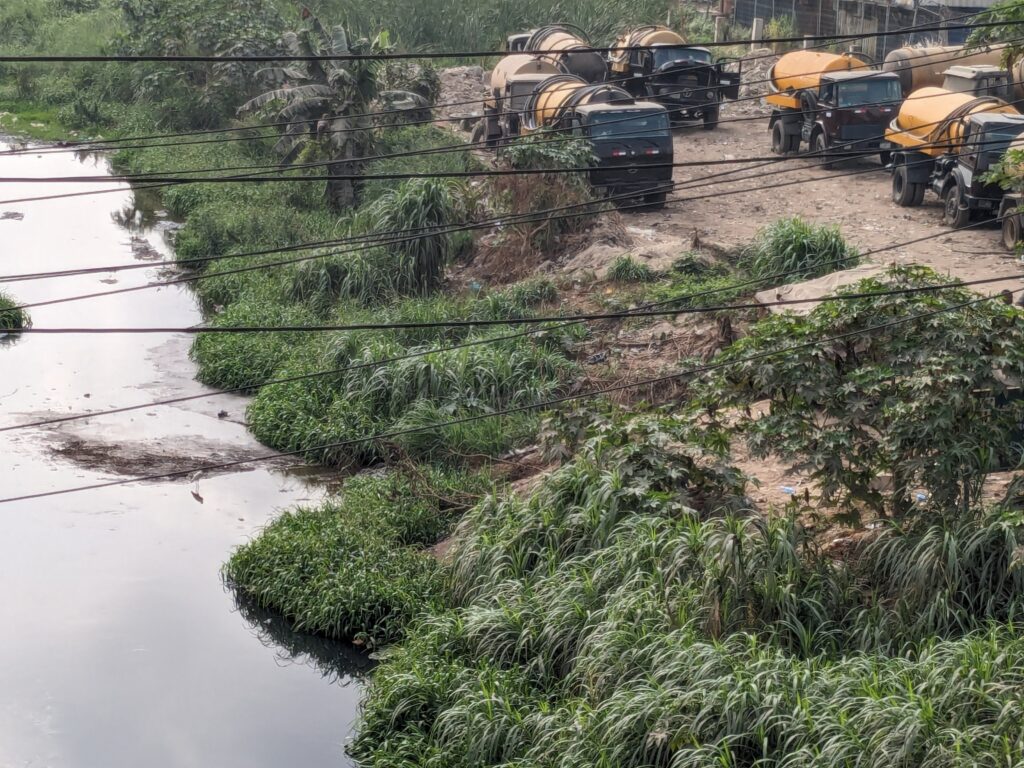
However, the Odo Iya Alaro Wastewater Treatment Plant only does the preliminary treatment, after which the wastewater is released into the river water, FIJ has found.
This directly poses health risks to people as well as aquatic life. The overall head of the plant was almost tight-lipped when this newspaper approached him for an interview on this story. He said he had no right to speak to the media. He went on to say a few things before pointing out that the Lagos State Wastewater Management Office (LSWMO), which maintains wastewater infrastructure, was the only entity that could speak or authorise him to speak with FIJ.
“What we do here is a pre-treatment that involves the application of chloroquine and the removal of solid materials before discharging the wastewater into the river,” the man said.
He also told FIJ on February 20 that “we do not have access to the sewer line, which is expensive to maintain”.
“But the Lagos State government is already working on that,” he said. Obviously, he was aware that poor treatment could cause an epidemic. “So, after removing all the sludge, we will apply chloroquine to it in order to manageably reduce the risk of an epidemic.”
Before interviewing him, this newspaper had interviewed a lady, who identified herself as Temitope Afodewu, on February 15. Although she could not specify the length, she claimed that the plant had a part of the river assigned to it for maintenance.
“Once we clear our own part, the community should continue from there and clear their own part, too,” Afodewu, who said she was working at the plant as a secretary, told FIJ. “It is not what we do on a regular basis. The community members are not united. Otherwise, they should have come here for a dialogue on how to better handle it. This kind of problem is not new. It once happened at Abesan Estate.
“At that place, sewage was directly leaking into residential places where you even have schoolchildren playing around. They sought an understanding with the plant’s management and the problem was eventually addressed. Today, you can’t see any like that there again.”
She said the community could have sent a representative to the facility for a dialogue rather than speak to the media.
Various reports have corroborated Afodewu’s statement that this is not new. A resident of the Abesan Estate, where a wastewater treatment plant is located, said in an investigation by The PUNCH in January 2023 that “you will see effluent waste flowing everywhere….and people are complaining.”
There is a strong indication that the same person manages both the Abesan and Odo Iya Alaro treatment plants. From that newspaper’s findings, Chief Tunde Afodewu was the facility manager at Abesan, and FIJ also found that the secretary at Odo Iya Alaro had ‘Afodewu’ in her name. Additionally, the lady’s knowledge of how bad the situation was at Abesan before the community raised the alarm is also an indicator that both plants are under one management and possibly a family business at best.
This finding shows a concerning pattern. The management has a lukewarm attitude towards the people and the environment in which it operates. As it does at Abesan, so it does in Odo Iya Alaro. But somehow, it has managed to escape regulatory accountability.
CONSEQUENCES ON THE ENVIRONMENT
Poor management of wastewater, said the LSWMO via its dormant Facebook page, pollutes the groundwater sources and causes waterborne diseases such as cholera, typhoid fever and dysentery. Other implications of this are the contamination of water bodies, leading to the loss of aquatic life such as fish, crabs and shrimp.
Efforts to speak with the LSWMO were not entirely successful. Olufemi Ogun, whose phone number was listed on the agency’s website, was unreachable. However, an agent of agency responded to FIJ’s direct message on X on Thursday: “We promise to attend to this immediately and you will be updated.”
As of press time, no feedback had been provided.
Evidently, the operation of the plant has had some of these effects on the Ojota and Mende communities. Separate research evidence has pointed this out. The situation is also compounded by a dumpsite close to the riverside.
Nigeria saw its worst rate of cholera outbreak cases in 2021 with about 69,925 suspected cases occurring in 25 states and the Federal Capital Territory, said the Nigeria Centre for Disease Control (NCDC). Of this figure, 2,323 people died. To cap it all, environmental health has been described as the weakest item in the Nigeria’s One Health System.
Furthermore, an estimated 14 million Nigerians live in locations conducive for the spread of cholera and other water-borne diseases, some of which are in Lagos State. Apart from a cholera outbreak in Isolo in 2016, some communities in 2023 have voiced out their fear about imminent cholera disaster due to blocked water channels and sanitary inadequacies. Tackling the disposal of poorly treated wastewater into Odo Iya Alaro, according to residents, was a matter of emergency.
Meanwhile, the Lagos State government, through Tokunbo Wahab’s Ministry of Environment and Water Resources, signed a memorandum of understanding with a Ghanaian firm to facilitate an effective system of treating “solid and liquid wastes in the state and to establish a Material Recovery Facility to reduce downstream pressure (waste disposal volume) at landfills”.
The most recent air quality index released by the Lagos State Environmental Protection Agency reveals disturbing statistics. Specifically, the figure for Mende was 44.8, described as unhealthy for sensitive groups of people.
READ ALSO: INVESTIGATION: Why Container-Laden Trucks Kill Lagos Residents
Back in 2007, Adeyemi, et al., referenced in a postdoctoral thesis submitted to Canada’s University of Ottawa, themed “Sustainable Groundwater Management in Lagos: The Regulatory Framework,” and written by Adebola Ogunba, investigated the physicochemical and microbial qualities of two wells and two boreholes in the community. Results of the physical chemistry of the water indicated high levels of heavy metals, including lead, cadmium, and chromium, while its microbial characteristics showed harmful coliform bacteria, including e. coli, salmonella and shigella.
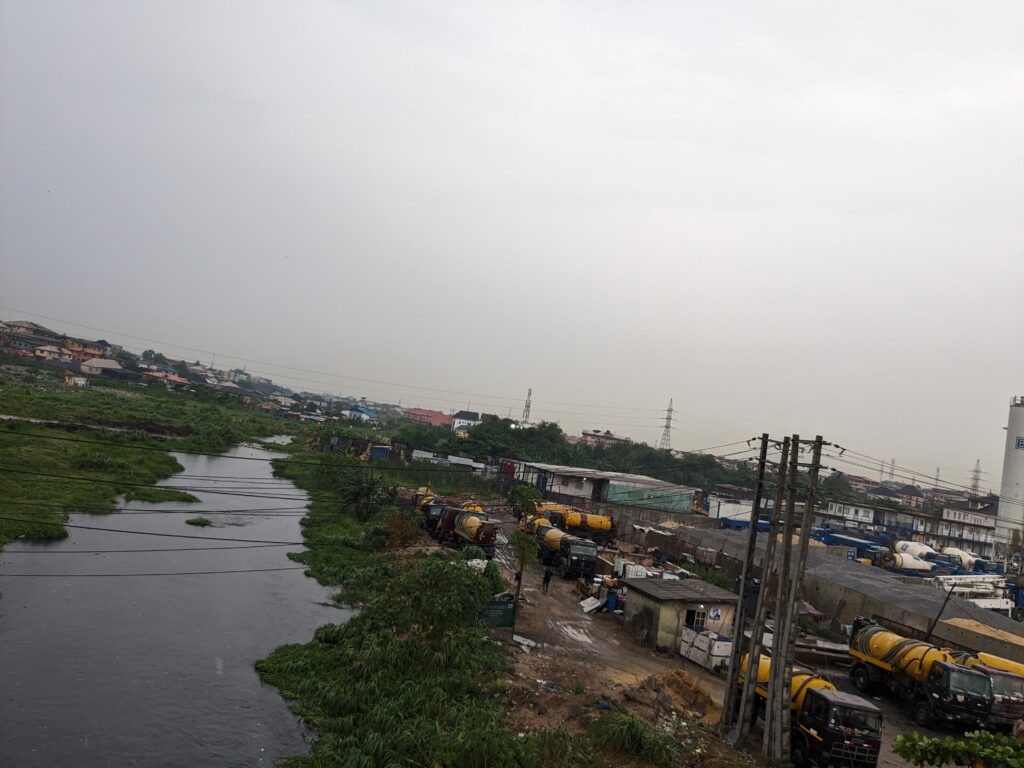
Furthermore, 2023 ecological research into the pollution level in the area strengthened the fact that poor waste management culture had contaminated the soil in the plant’s area. Away from the immediate river bank, a group of four researchers, Isiaka Adio Hassan, Wahabi Olaitan Abdul Raheem, Aishat Adejoke Obalola, Isiaq Oluwole Bello, investigated the Odo Iya Alaro topsoil and subsoil.
“The river is dark in colour with bad odour; which are signs of being polluted with all sorts of waste (human, domestic, and industrial)…. The industrial wastewaters are discharged some kilometres away from Ikeja into a rectangular-shaped concrete canal, which eventually empties into Odo Iya-Alaro (a natural river),” the researchers wrote.
The soil had been heavily polluted, they found. Among other things, they recommended thorough detoxification of effluents “into a non-toxic state before discharging them into the water body. Solid waste should be discouraged from being emptied into the river or canal.”
Editor’s Note: The asterisked names are pseudonyms.
Produced with support from the Wole Soyinka Centre for Investigative Journalism (WSCIJ) under the Collaborative Media Engagement for Development Inclusivity and Accountability project (CMEDIA) funded by the MacArthur Foundation
Subscribe
Be the first to receive special investigative reports and features in your inbox.


